|
The heart of Boston is
sandwiched between Boston Common and the harbor. Unlike many US cities,
Boston has held tenaciously to its past and there are reminders of
nearly four centuries of history embedded in the center of this modern
metropolis. The 18th-century grace of historic buildings like the Old
State House still shines within a canyon of skyscrapers. Even the heroes
of Boston’s early years remain here – city founder John Winthrop,
patriot Paul Revere, and revolutionary Samuel Adams are buried just
steps from sidewalks abuzz with shoppers. Rolled in to this amorphous
area is Faneuil Hall Marketplace,
the oldest of Boston’s commercial districts, and the Financial
District, which stands as testament to Boston’s continuing worldwide
economic clout.
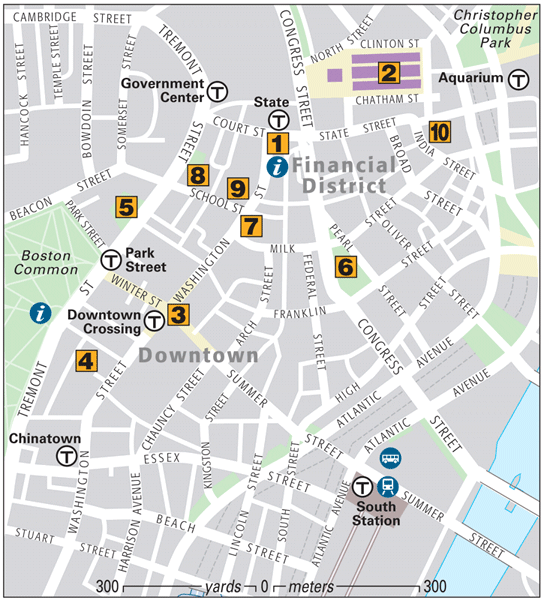
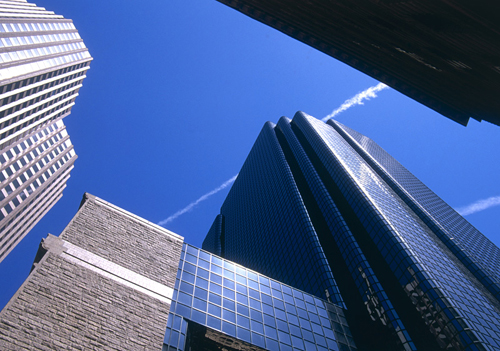
AttractionsOld State House Built
in 1713 as the seat of colonial government, the Old State House was
designed to look down State Street to the shipping hub of Long Wharf. In
1770, the Boston Massacre
occurred outside its doors, and on July 4, 1776, the Declaration of
Independence was first read to Bostonians from its balcony . Today, it’s home to the Bostonian Society & Old State House Museum.
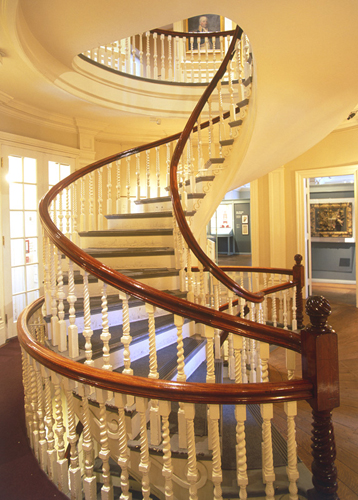
Central staircase, Old State House
Faneuil Hall Marketplace Many
a fiery speech urging revolution echoed in Faneuil Hall in the late
18th century; in the 1820s it was the city’s food distribution that was
revolutionized in adjacent Quincy Market. Today the buildings and
surrounding plazas form a festival marketplace – the successful model
for dozens of markets worldwide .
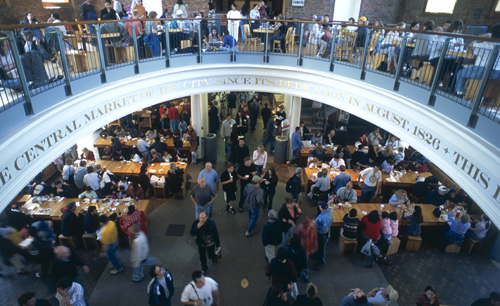
Interior, Quincy Market
Downtown Crossing This
pedestrian shopping area is flanked by Filene’s Basement and Macy’s
department store (closed until 2010). Pushcart vendors and downtown
office workers fill the streets here.
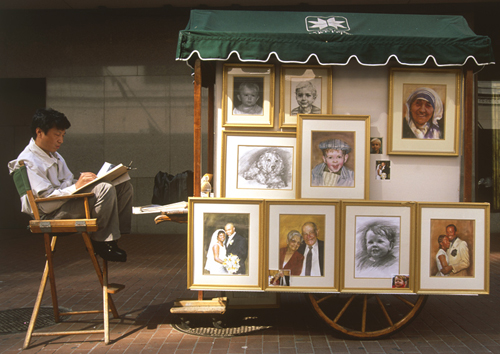
Downtown Crossing department store
Ladder District The
network of short streets connecting Washington and Tremont streets has,
in recent years, assumed a new identity as the Ladder District. Once
derelict and abandoned after dark, the area now throbs with clubs, bars,
and restaurants. Anchoring the new district, the Millennium Tower
houses the ultra-chic Ritz-Carlton Boston Common and the top-of-the-line Loews Cineplex (175 Tremont St). A few stalwarts, such as the landmark used-book seller, Brattle Book Shop, are holding out against the moneyed big boys. Old Granary Burying Ground Dating
from 1660, the Granary contains the graves of many of Boston’s most
illustrious figures, including John Hancock, Samuel Adams, and Paul
Revere (see Figures in Boston History)
who joined his revolutionary comrades here in 1818. Other notables
include the hugely influential architect Charles Bulfinch, Benjamin
Franklin’s parents, and Crispus Attucks – an escaped slave who was
allegedly the first casualty of the so-dubbed Boston Massacre. Tremont St at Park St 617 635 4505 Open 9 am–5pm daily Free
Post Office Square On
a sunny day this green oasis is filled with office workers. Surrounding
the park are several of the area’s most architecturally distinctive
buildings, including the Art Deco post office building (Congress St),
the Renaissance revival former Federal Reserve building (now the Langham Boston hotel), and the Art Moderne Verizon building (185 Franklin St). The lobby of the latter houses a small telephone museum and has labor murals celebrating the telephone industry workers.
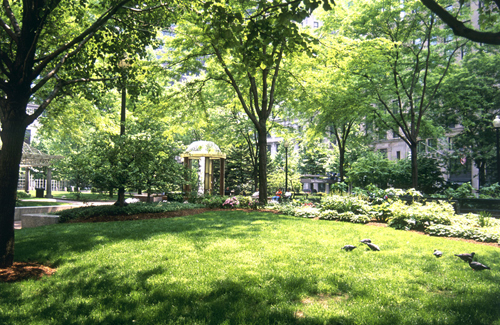
Post Office Square
Old South Meeting House Old
South’s rafters have rung with many impassioned speeches exhorting the
overthrow of the king, the abolition of slavery, women’s right to vote,
an end to apartheid, and many other causes. Nearly abandoned when its
congregation moved to Back Bay in 1876, it was saved in one of Boston’s
first acts of preservation.
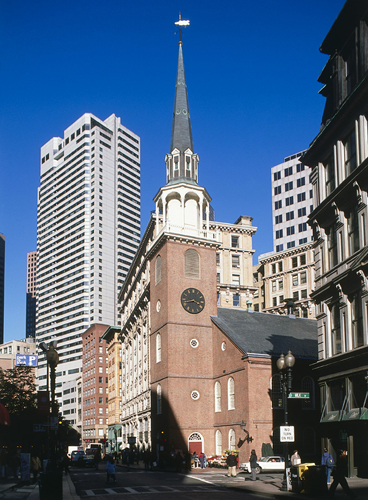
Old South Meeting House
King’s Chapel The
first Anglican Church in Puritan Boston was established in 1686 to
serve the British Army officers. When the majority of Anglicans fled
Boston along with retreating British forces in the evacuation of 1776,
the chapel became the first Unitarian Church in the New World. The
church is known for its program of classical concerts. 58 Tremont St 617 523 1749 Open
May–early Sep: 1:30pm–4pm Sun, 10am–4pm Mon, Thu, Fri, Sat,
10am–11:15am & 1:30–4pm Tue–Wed (call for off-season hours).
Recitals: 12:15pm Tue
www.kings-chapel.org

Interior, King’s Chapel
Old Corner Bookstore This
enduring spot on the Freedom Trail remains one of the most tangible
sites associated with the writers of the New England Renaissance of the
last half of the 19th century. Both the Atlantic Monthly
magazine and Ticknor & Fields (publishers of Ralph Waldo Emerson
and Henry David Thoreau) made this modest structure its headquarters
during the mid- and late 19th century, when Boston was the literary,
intellectual, and publishing center of the country. Saving the site from
demolition in 1960 led to the formation of Historic Boston
Incorporated. The building, however, is no longer connected to
publishing. Custom House When
the Custom House was built in 1840, Boston was one of America’s largest
overseas shipping ports, and customs fees were the mainstay of the
Federal budget. The Neo-Classical structure once sat on the waterfront,
but now stands two blocks inland. The 16-story Custom House tower, added
in 1913, was Boston’s first skyscraper. Since the 1990s, peregrine
falcons have nested in the clock tower under the watchful eyes of
wildlife biologists. The lobby displays a few artifacts from the Peabody
Essex Museum in Salem, and tours of the tower give sweeping harbor
views.
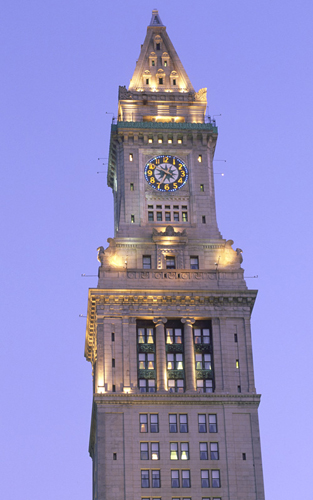
Custom House Tower
|